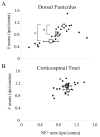Reimplantation of avulsed lumbosacral ventral roots in the rat ameliorates injury-induced degeneration of primary afferent axon collaterals in the spinal dorsal columns
- PMID: 18291596
- PMCID: PMC2756496
- DOI: 10.1016/j.neuroscience.2007.11.043
Reimplantation of avulsed lumbosacral ventral roots in the rat ameliorates injury-induced degeneration of primary afferent axon collaterals in the spinal dorsal columns
Abstract
Injuries to the cauda equina/conus medullaris portion of the spinal cord can result in motor, sensory, and autonomic dysfunction, and neuropathic pain. In rats, unilateral avulsion of the motor efferents from the lumbosacral spinal cord results in at-level allodynia, along with a corresponding glial and inflammatory response in the dorsal horn of the spinal cord segments immediately rostral to the lesion. Here, we investigated the fate of intramedullary primary sensory projections following a motor efferent lesion. The lumbosacral (L6 and S1) ventral roots were unilaterally avulsed from the rat spinal cord (VRA; n=9). A second experimental group had the avulsed roots acutely reimplanted into the lateral funiculus (Imp; n=5), as this neural repair strategy is neuroprotective, and promotes the functional reinnervation of peripheral targets. A laminectomy-only group served as controls (Lam; n=7). At 8 weeks post-lesion, immunohistochemical examination showed a 42% reduction (P<0.001) in the number of RT97-positive axons in the ascending tracts of the dorsal funiculus of the L4-5 spinal segment in VRA rats. Evidence for degenerating myelin was also present. Reimplantation of the avulsed roots ameliorated axon and myelin degeneration. Axons in the descending dorsal corticospinal tract were unaffected in all groups, suggesting a specificity of this lesion for spinal primary sensory afferents. These results show for the first time that a lesion restricted to motor roots can induce the degeneration of intramedullary sensory afferents. Importantly, reimplantation of the lesioned motor roots ameliorated sensory axon degeneration. These data further support the therapeutic potential for reimplantation of avulsed ventral roots following trauma to the cauda equina/conus medullaris.
Figures






References
-
- Aldskogius H, Cerne H, Holmberg A. The effect of sciatic nerve transection on myelinated fibers in the L5 dorsal root and lumbar dorsal column. A Marchi study in the rat. Anat Embryol. 1985;171:181–186. - PubMed
-
- Baker KA, Hagg T. An adult rat spinal cord contusion model of sensory axon degeneration: the estrus cycle or a preconditioning lesion do not affect outcome. J Neurotrauma. 2005;22:415–428. - PubMed
-
- Blight AR, Decrescito V. Morphometric analysis of experimental spinal cord injury in the cat: the relation of injury intensity to survival of myelinated axons. Neuroscience. 1986;19:321–341. - PubMed
-
- Carlstedt T, Anand P, Hallin R, Misra PV, Noren G, Seferlis T. Spinal nerve root repair and reimplantation of avulsed ventral roots into the spinal cord after brachial plexus injury. J Neurosurg. 2000;93:237–247. - PubMed
Publication types
MeSH terms
Substances
Grants and funding
LinkOut - more resources
Full Text Sources
Medical

